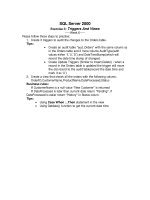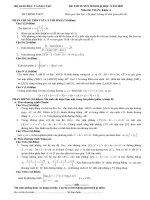Đề thi về SQL
Bạn đang xem bản rút gọn của tài liệu. Xem và tải ngay bản đầy đủ của tài liệu tại đây (219.46 KB, 26 trang )
SQL
Câu hỏi 1:
You are a database developer for a mail order company. The company has two SQL
Server 2000 computers named CORP1 and CORP2. CORP1 is the online transaction
processing server. CORP2 stores historical sales data. CORP2 has been added as a
linked server to CORP1. The manager of the sales department asks you to create a list
of customers who have purchased floppy disks. This list will be generated each month
for promotional mailings. Floppy disks are represented in the database with a
category ID of 21. You must retrieve this information from a table named
SalesHistory. This table is located in the Archive database, which resides on CORP2.
You need to execute this query from CORP1.
Which script should you use?
A. EXEC sp_addlinkedserver ‘CORP2’, ‘SQL Server’
GO
SELECT CustomerID FROM CORP2.Archive.dbo.SalesHistory
WHERE CategoryID = 21
B. SELECT CustomerID FROM OPENROWSET (‘SQLOLEDB’, ‘CORP2’; ‘p*word’,
‘SELECT
CustomerID FROM Archive.dbo.SalesHistory WHERE CategoryID = 21’)
C. SELECT CustomerID FROM CORP2.Archive.dbo.SalesHistory
WHERE CategoryID = 21
D. EXEC sp_addserver ‘CORP2’
GO
SELECT CustomerID FROM CORP2.Archive.dbo.SalesHistory
WHERE CategoryID = 21
Answer: C.
Câu hỏi 2:
You are a database developer for wide world importers. You are creating a database
that will store order information. Orders will be entered in a client/server application.
Each time a new order is entered, a unique order number must be assigned. Order
numbers must be assigned in ascending order. An average of 10, 000 orders will be
entered each day. You create a new table named Orders and add an OrderNumber
column to this table.
What should you do next?
A. Set the data type of the column to uniqueidentifier.
B. Set the data type of the column to int, and set the IDENTITY property for the column.
C. Set the data type of the column to int.
Create a user-defined function that selects the maximum order number in the table.
D. Set the data type of the column to int.
Create a NextKey table, and add a NextOrder column to the table.
Set the data type of the NextOrder column to int.
Create a stored procedure to retrieve and update the value held in the NextKey.
Answer: B.
Câu hỏi 3:
You are designing a database that will contain customer orders. Customers will be
able to order multiple products each time they place an order. You review the
database design, which is shown in the exhibit.
You want to promote quick response times for queries and minimize redundant data.
What should you
do? (Each correct answer presents part of the solution. Choose two.)
A. Create a new order table named OrderDetail.
Add OrderID, ProductID, and Quantity columns to this table.
B. Create a composite PRIMARY KEY constraint on the OrderID and ProductID
columns of the
Orders table.
C. Remove the ProductID and Quantity columns from the Orders table.
D. Create a UNIQUE constraint on the OrderID column of the Orders table.
E. Move the UnitPrice column from the Products table to the Orders table.
Answer: A, C.
Câu hỏi 4:
You are the database developer for a publishing company. You create the following
stored procedure to report the year-to-date sales for a particular book title:
CREATE PROCEDURE get_sales_for_title
%title varchar(80), @ytd_sales int OUTPUT
AS
SELECT @ytd_sales = ytd_sales
FROM titles
WHERE title = @title
IF @@ROWCOUNT = 0
RETURN(-1)
ELSE
RETURN(0)
You are creating a script that will execute this stored procedure. If the stored
procedure executes successfully, it should report the year-to-date sales for the book
title. If the stored procedure fails to execute, it should report the following message:
“No Sales Found”
How should you create the script?
A. DECLARE @retval int
DECLARE @ytd int
EXEC get_sales_for_title ‘Net Etiquette’, @ytd
IF @retval < 0
PRINT ‘No sales found’
ELSE
PRINT ‘Year to date sales: ’ + STR (@ytd)
GO
B. DECLARE @retval int
DECLARE @ytd int
EXEC get_sales_for_title ‘Net Etiquette’, @ytd OUTPUT
IF @retval < 0
PRINT ‘No sales found’
ELSE
PRINT ‘Year to date sales: ’ + STR (@ytd)
GO
C. DECLARE @retval int
DECLARE @ytd int
EXEC get_sales_for_title ‘Net Etiquette’,@retval OUTPUT
IF @retval < 0
PRINT ‘No sales found’
ELSE
PRINT ‘Year to date sales: ’ + STR (@ytd)
GO
D. DECLARE @retval int
DECLARE @ytd int
EXEC @retval = get_sales_for_title ‘Net Etiquette’, @ytd OUTPUT
IF @retval < 0
PRINT ‘No sales found’
ELSE
PRINT ‘Year to date sales: ’ + STR (@ytd)
GO
Answer: D.
Câu hỏi 5:
You are a database developer for a hospital. There are four supply rooms on each
floor of the hospital, and the hospital has 26 floors. You are designing an inventory
control database for disposable equipment. Certain disposable items must be kept
stored at all times. As each item is used, a barcode is scanned to reduce the inventory
count in the database. The supply manager should be paged as soon as a supply room
has less than the minimum quantity of an item.
What should you do?
A. Create a stored procedure that will be called to update the inventory table. If the
resultant quantity is less
than the restocking quantity, use the xp_logevent system stored procedure to page the
supply manager.
B. Create an INSTEAD OF UPDATE trigger on the inventory table. If the quantity in the
inserted table is
less than the restocking quantity, use SQLAgentMail to send an e-mail message to the
supply manager’s
pager.
C. Create a FOR UPDATE trigger on the inventory table. If the quantity in the inserted
table is less than
the restocking quantity, use the xp_sendmail system stored procedure to page the supply
manager.
D. Schedule the SQL server job to run at four-hour intervals.
Configure the job to use the @notify_level_page = 2 argument.
Configure the job so that it tests each item’s quantity against the restocking quantity.
Configure the job so that it returns a false value if the item requires restocking.
This will trigger the paging of the supply manager.
Answer: C.
Câu hỏi 6:
You are the database developer for a large brewery. Information about each of the
brewery’s plants and the equipment located at each plant is stored in a database
named Equipment. The plant information is stored in a table named Location, and
the equipment information is stored in a table named Parts. The scripts that were
used to create these tables are shown in the Location and Parts Scripts exhibit.
CREATE TABLE Location
(
LocationID int NOT NULL,
LocationName char (30) NOT NULL UNIQUE,
CONSTRAINT PK_Location PRIMARY KEY (LocationID)
)
CREATE TABLE Parts
(
PartID int NOT NULL,
LocationID int NOT NULL,
PartName char (30) NOT NULL,
CONSTRAINT PK_Parts PRIMARY KEY (PartID),
CONSTRAINT FK_PartsLocation FOREIGN KEY (Location ID)
REFERENCES Location (LocationID)
)
The brewery is in the process of closing several existing plants and opening several
new plants. When a plant is closed, the information about the plant and all of the
equipment at that plant must be deleted from the database. You have created a stored
procedure to perform this operation. The stored procedure is shown in the Script for
sp_DeleteLocation exhibit.
CREATE PROCEDURE sp_DeleteLocation @LocName char(30) AS
BEGIN
DECLARE @PartID int
DECLARE crs_Parts CURSOR FOR
SELECT p.PartID
FROM Parts AS p INNER JOIN Location AS 1
ON p.LocationID = @LocName
WHERE l.LocationName = @LocName
OPEN crs_Parts
FETCH NEXT FROM crs_Parts INTO @PartID
WHILE (@@FETCH_STATUS <> -1)
BEGIN
DELETE Parts WHERE CURRENT OF crs_Parts
FETCH NEXT FROM crs_Parts INTO @PartID
END
CLOSE crs_Parts
DEALLOCATE crs_Parts
DELETE Location WHERE LocationName = @LocName
END
This procedure is taking longer than expected to execute. You need to reduce the
execution time of the procedure.
What should you do?
A. Add the WITH RECOMPILE option to the procedure definition.
B. Replace the cursor operation with a single DELETE statement.
C. Add a BEGIN TRAN statement to the beginning of the procedure, and add a COMMIT
TRAN
statement to the end of the procedure.
D. Set the transaction isolation level to READ UNCOMMITTED for the procedure.
E. Add a nonclustered index on the PartID column of the Parts table.
Answer: B.
Câu hỏi 7:
You are a member of a database development team for a telecommunications
company. Another developer on the team, Marc, has created a table named
Customers in the Corporate database. Because the table contains confidential
information, he has granted SELECT permissions on the table only to the other
members of your team.
You are developing an application that will allow employees in the marketing
department to view some of the information in the Customers table. These employees
are all members of the Marketing database role. To support this application, you
create a view named vwCustomers on the Customers table. After creating the view,
you grant SELECT permissions on the view to the Marketing role. When members of
the Marketing role attempt to retrieve data from the view, they receive the following
error message:
SELECT permission denied on object ‘Customers’, database
‘Corporate’, owner
‘Marc’.
You must ensure that the members of the Marketing role can only use the
vwCustomers view to access the data in the Customers table. What should you do?
A. Add the marketing role to the sysadmin fixed server role.
B. Transfer the ownership of the vwCustomers view to the marketing role.
C. Instruct Marc to transfer the ownership of the Customers table to each member of the
marketing role.
D. Instruct Marc to grant the users SELECT permissions on the Customers table.
E. Drop the vwCustomers view. Instruct Marc to re-create the view and to grant SELECT
permissions on
the view to the marketing role.
Answer: E.
Câu hỏi 8:
You are a database developer for a large travel company. Information about each of
the company’s departments is stored in a table named Department. Data about each
of the company’s travel agents and department managers is stored in a table named
Employees. The SQLLogin column of the Employees table contains the database login
for the travel agent or department manager. The Department and Employees table
are shown in the exhibit.
Each department manager has been added to the Managers database role. You need
to allow members of this database role to view all of the data in the department table.
Members of this role should be able to insert or update only the row that pertains to
their department.
You grant the Managers database role SELECT permissions on the Department
table. What should you do next?
A. Create a trigger on the Department table that checks whether the database login of the
user performing
the insert or update operation belongs to a member of that department.
B. Create a view that includes all columns in the Department table and the SQLLogin
column from the
Employees table.
C. Include the WITH CHECK OPTION clause in the view definition.
D. Grant INSERT and UPDATE permissions on the Department table.
E. Grant INSERT and UPDATE permissions on the SQLLogin column of the Employees
table.
Answer: B.
Câu hỏi 9:
You are a database developer for FSS's SQL Server 2000 database. This database
contains a table named Sales, which has 2 million rows. The Sales table contains sales
information for all departments in the company. Each department is identified in the
table by the DepartmentID column. Most queries against the table are used to find
sales for a single department. You want to increase the I/O performance of these
queries. However, you do not want to affect the applications that access the table.
What should you do?
A. Create a new table, and move the columns that are most frequently queried to this table.
Retain the DepartmentID column in both tables.
Create a view on the original table and on the new table.
Add a FOREIGN KEY constraint on the join columns of the new table.
B. Create a new table, and move the columns that are most frequently queried to this table.
Retain the DepartmentID column in both tables.
Create a view on the original table and on the new table.
Add a CHECK constraint on the DepartmentID columns of both tables.
C. Create one new table for each department, and move the sales information for each
department to that
department’s table.
Add a CHECK constraint on the DepartmentID columns of the new tables.
Create a view on the new tables.
D. Create one new table for each department, and move the sales information for each
department to that
department’s table.
Create a view on the new tables.
Add a CHECK constraint on the DepartmentID column in the view.
E. Create a stored procedure that accepts an input parameter for the department.
Use the stored procedure to return results from the Sales table.
Answer: C.
Câu hỏi 10:
You are a database developer for FSS’s SQL Server 2000 database. You are deleting
objects in the database that are no longer used. You are unable to drop the 1997Sales
view. After investigation, you find that the view has the following characteristics:
There is a clustered index on the view
The sales database role has permissions on the view.
The view uses the WITH SCHEMABINDING option.
A schema-bound inline function references the view
An INSTEAD OF trigger is defined on the view
What should you do before you can drop the view?
A. Drop the clustered index on the view.
B. Remove all permissions from the view.
C. Remove the WITH SCHEMABINDING option from the view.
D. Remove the WITH SCHEMABINDING option from the function that is referencing the
view.
E. Disable the INSTEAD OF trigger on the view.
Answer: D.
Câu hỏi 11:
You are the database developer for FSS’s Accounting database. The database
contains a table named Employees. Tom is a member of the accounting department.
Tom’s database user account has been denied SELECT permissions on the Salary
and BonusPercentage columns of the Employees table. Tom has been granted
SELECT permissions on all other columns in the table. Tom now requires access to
all the data in the Employees table.
What should you do?
A. Revoke SELECT permissions on the Salary and BonusPercentage columns of the
Employees table for
Tom’s database user account.
B. Add Tom to the db_datareader database role.
C. Add Tom to the db_accessadmin database role.
D. Grant SELECT permissions on the Salary and BonusPercentage columns of the
Employees table for
Tom’s database user account.
Answer: D.
Câu hỏi 12:
You are a database developer for a company that produces an online telephone
directory. A table named PhoneNumbers is shown in the exhibit.
After loading 100,000 names into the table, you create indexes by using the following
script:
ALTER TABLE [dbo]. [PhoneNumbers] WITH NOCHECK ADD
CONSTRAINT[PK_PhoneNumbers]PRIMARY KEY CLUSTERED (
[FirstName],
[LastName],
) ON [PRIMARY]
GO
CREATE UNIQUE INDEX
[IX_PhoneNumbers] ON [dbo].[PhoneNumbers](
[PhoneNumberID]
) ON [PRIMARY]
GO
You are testing the performance of the database. You notice that queries such as the
following take a long time to execute:
Return all names and phone numbers for persons who live in a certain city and whose
last name begins with ‘W’ How should you improve the processing performance of
these types of queries? (Each correct answer presents part of the solution. Choose
two.)
A. Change the PRIMARY KEY constraint to use the LastName column followed by the
FirstName
column.
B. Add a nonclustered index on the City column.
C. Add a nonclustered index on the AreaCode, Exchange, and Number columns.
D. Remove the unique index from the PhoneNumberID column.
E. Change the PRIMARY KEY constraints to nonclustered indexes.
F. Execute on UPDATE STATISTICS FULLSCAN ALL statements in SQL Query
Analyzer.
Answer: A, B.
Câu hỏi 13:
You are a database developer for a hospital. You are designing a SQL Server 2000
database that will contain physician and patient information. This database will
contain a table named Physicians and a table named Patients. Physicians treat
multiple patients. Patients have a primary physician and usually have a secondary
physician. The primary physician must be identified as the primary physician. The
Patients table will contain no more than 2 million rows. You want to increase I/O
performance when data is selected from the tables. The database should be
normalized to the third normal form.
Which script should you use to create the tables?
A. CREATE TABLE Physicians
(
Physicians ID int NOT NULL CONSTRAINT PK_Physicians PRIMARY KEY
CLUSTERED,
LastName varchar(25) NOT NULL,
)
GO
CREATE TABLE Patients
(
PatientID bigint NOT NULL CONSTRAINT PK_Patients PRIMARY KEY
CLUSTERED,
LastName varchar (25) NOT NULL,
FirstName varchar (25) NOT NULL,
PrimaryPhysician int NOT NULL,
SecondaryPhysician int NOT NULL,
CONSTRAINT PK_Patients_Physicians1 FOREIGN KEY (PrimaryPhysician)
REFERENCES
Physicians (PhysicianID),
CONSTRAINT PK_Patients_Physicians2 FOREIGN KEY (SecondaryPhysician)
REFERENCES
Physicians (PhysicianID)
)
B. CREATE TABLE Patients
(
PatientID smallint NOT NULL CONSTRAINT PK_Patients PRIMARY KEY
CLUSTERED,
LastName varchar(25) NOT NULL,
FirstName varchar (25) NOT NULL,
PrimaryPhysician int NOT NULL,
SecondaryPhysician int NOT NULL,
)
GO
CREATE TABLE Physicians









